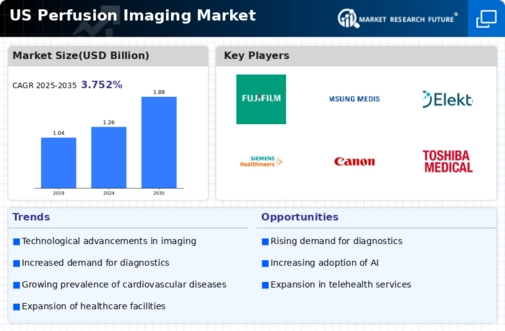Rising Awareness of Early Disease Detection
Growing awareness of early disease detection is a crucial driver for the perfusion imaging market. Educational campaigns and initiatives by healthcare organizations are emphasizing the benefits of early diagnosis in improving treatment outcomes. As patients become more informed about cardiovascular health, they are more likely to seek diagnostic imaging services. This trend is further supported by the increasing availability of health insurance coverage for imaging procedures, making them more accessible to a broader population. As awareness continues to rise, the demand for perfusion imaging is expected to grow, as it provides critical information for early intervention and management of cardiovascular diseases. The market may see a surge in utilization as healthcare providers respond to this heightened awareness.
Rising Incidence of Cardiovascular Diseases
The increasing prevalence of cardiovascular diseases in the US is a primary driver for the perfusion imaging market. According to the American Heart Association, cardiovascular diseases account for approximately 697,000 deaths annually, highlighting the urgent need for effective diagnostic tools. Perfusion imaging plays a crucial role in assessing blood flow and identifying areas of ischemia, thereby facilitating timely interventions. As healthcare providers seek to improve patient outcomes, the demand for advanced imaging techniques is likely to rise. This trend is further supported by the growing aging population, which is more susceptible to heart-related conditions. Consequently, the perfusion imaging market is expected to experience substantial growth as healthcare systems prioritize early detection and management of cardiovascular diseases.
Technological Innovations in Imaging Techniques
Technological advancements in imaging modalities are significantly influencing the perfusion imaging market. Innovations such as hybrid imaging systems, including PET/CT and SPECT/CT, enhance the accuracy and efficiency of perfusion assessments. These systems allow for simultaneous anatomical and functional imaging, providing comprehensive insights into cardiovascular health. Furthermore, the integration of artificial intelligence and machine learning algorithms into imaging software is streamlining image analysis, reducing interpretation time, and improving diagnostic precision. As these technologies become more accessible, healthcare facilities are likely to adopt them, driving the growth of the perfusion imaging market. The market is projected to expand. Providers are investing in state-of-the-art imaging solutions to meet the increasing demand for accurate and timely diagnostics.
Increased Investment in Healthcare Infrastructure
The ongoing investment in healthcare infrastructure in the US is likely to bolster the perfusion imaging market. Government initiatives and private sector funding are directed towards enhancing healthcare facilities, particularly in underserved areas. This expansion includes the acquisition of advanced imaging technologies, which are essential for accurate diagnostics and treatment planning. As hospitals and clinics upgrade their equipment, the demand for perfusion imaging systems is expected to increase. Additionally, the emphasis on improving healthcare access and quality aligns with the growing need for effective diagnostic tools. Consequently, the perfusion imaging market may experience growth as healthcare providers seek to enhance their diagnostic capabilities and improve patient care.
Growing Demand for Non-Invasive Diagnostic Procedures
The shift towards non-invasive diagnostic methods significantly propels the perfusion imaging market. Patients and healthcare providers increasingly prefer non-invasive techniques due to their lower risk profiles and reduced recovery times. Perfusion imaging, being a non-invasive procedure, aligns with this trend, offering valuable insights into blood flow without the need for invasive interventions. This preference is particularly evident in the management of cardiovascular diseases, where timely and accurate diagnosis is critical. As awareness of the benefits of non-invasive imaging grows, the demand for perfusion imaging is expected to rise. The market may witness an increase in adoption rates. Healthcare systems are prioritizing patient safety and comfort while ensuring effective diagnostic capabilities.


















Leave a Comment